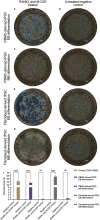This is a preprint.
Comparison of osteoclast differentiation protocols from human induced pluripotent stem cells of different tissue origins
- PMID: 37461708
- PMCID: PMC10350192
- DOI: 10.21203/rs.3.rs-3089289/v1
Comparison of osteoclast differentiation protocols from human induced pluripotent stem cells of different tissue origins
Update in
-
Comparison of osteoclast differentiation protocols from human induced pluripotent stem cells of different tissue origins.Stem Cell Res Ther. 2023 Nov 7;14(1):319. doi: 10.1186/s13287-023-03547-6. Stem Cell Res Ther. 2023. PMID: 37936199 Free PMC article.
Abstract
Background: Ever since their discovery, induced pluripotent stem cells (iPSCs) have been extensively differentiated into a large variety of cell types. However, a limited amount of work has been dedicated to differentiating iPSCs into osteoclasts. While several differentiation protocols have been published, it remains unclear which protocols or differentiation methods are preferrable regarding the differentiation of osteoclasts.
Methods: In this study we compare the osteoclastogenesis capacity of a peripheral blood mononuclear cell (PBMC)-derived iPSC line to a fibroblast-derived iPSC line in conjunction with either embryoid body-based or monolayer-based differentiation strategies. Both cell lines and differentiation protocols were investigated regarding their ability to generate osteoclasts and their inherent robustness and ease of use. The ability of both cell lines to remain undifferentiated while propagating using a feeder-free system was assessed using alkaline phosphatase staining. This was followed by evaluating mesodermal differentiation and the characterization of hematopoietic progenitor cells using flow cytometry. Finally, osteoclast yield and functionality based on resorptive activity, Cathepsin K and tartrate-resistant acid phosphatase (TRAP) expression were assessed. Results were validated using qRT-PCR throughout the differentiation stages.
Results: Embryoid-body based differentiation yielded CD45+, CD14+, CD11b+ subpopulations which in turn differentiated into osteoclasts which demonstrated TRAP positivity, Cathepsin K expression and mineral resorptive capabilities. This was regardless of which iPSC line was used. Monolayer-based differentiation yielded lower quantities of hematopoietic cells that were mostly CD34+ and did not subsequently differentiate into osteoclasts.
Conclusions: The outcome of this study demonstrates the successful differentiation of osteoclasts from iPSCs in conjunction with the embryoid-based differentiation method, while the monolayer-based method did not yield osteoclasts. No differences were observed regarding osteoclast differentiation between the PBMC and fibroblast-derived iPSC lines.
Keywords: Human induced pluripotent stem cells; hematopoietic differentiation; mesodermal differentiation; mineral resorption; osteoclastogenesis; osteoclasts.
Conflict of interest statement
Competing interests The authors declare no competing interests.
Figures







Similar articles
-
Comparison of osteoclast differentiation protocols from human induced pluripotent stem cells of different tissue origins.Stem Cell Res Ther. 2023 Nov 7;14(1):319. doi: 10.1186/s13287-023-03547-6. Stem Cell Res Ther. 2023. PMID: 37936199 Free PMC article.
-
Differentiation and Characterization of Osteoclasts from Human Induced Pluripotent Stem Cells.J Vis Exp. 2024 Mar 22;(205):10.3791/66527. doi: 10.3791/66527. J Vis Exp. 2024. PMID: 38587386 Free PMC article.
-
Development of an in vitro culture method for stepwise differentiation of mouse embryonic stem cells and induced pluripotent stem cells into mature osteoclasts.J Bone Miner Metab. 2014 May;32(3):331-6. doi: 10.1007/s00774-013-0547-5. Epub 2013 Dec 24. J Bone Miner Metab. 2014. PMID: 24366621
-
A Practical Procedure for the In Vitro Generation of Human Osteoclasts and Their Characterization.Tissue Eng Part C Methods. 2021 Jul;27(7):421-432. doi: 10.1089/ten.TEC.2021.0122. Tissue Eng Part C Methods. 2021. PMID: 34162266
-
Identification and characterization of the new osteoclast progenitor with macrophage phenotypes being able to differentiate into mature osteoclasts.J Bone Miner Res. 2000 Aug;15(8):1477-88. doi: 10.1359/jbmr.2000.15.8.1477. J Bone Miner Res. 2000. PMID: 10934646
References
-
- Takahashi K, Yamanaka S. Induction of pluripotent stem cells from mouse embryonic and adult fibroblast cultures by defined factors. Cell [Internet]. 2006. Aug 25 [cited 2023 Mar 24];126(4):663–76. Available from: https://pubmed.ncbi.nlm.nih.gov/16904174/. - PubMed
-
- Wernig M, Meissner A, Foreman R, Brambrink T, Ku M, Hochedlinger K et al. In vitro reprogramming of fibroblasts into a pluripotent ES-cell-like state. Nature 2007 448:7151 [Internet]. 2007. Jun 6 [cited 2023 Mar 24];448(7151):318–24. Available from: https://www.nature.com/articles/nature05944. - PubMed
-
- Takahashi K, Tanabe K, Ohnuki M, Narita M, Ichisaka T, Tomoda K et al. Induction of Pluripotent Stem Cells from Adult Human Fibroblasts by Defined Factors. Cell [Internet]. 2007. Nov 30 [cited 2023 Mar 24];131(5):861–72. Available from: http://www.cell.com/article/S0092867407014717/fulltext. - PubMed
Publication types
Grants and funding
LinkOut - more resources
Full Text Sources
Research Materials
Miscellaneous

